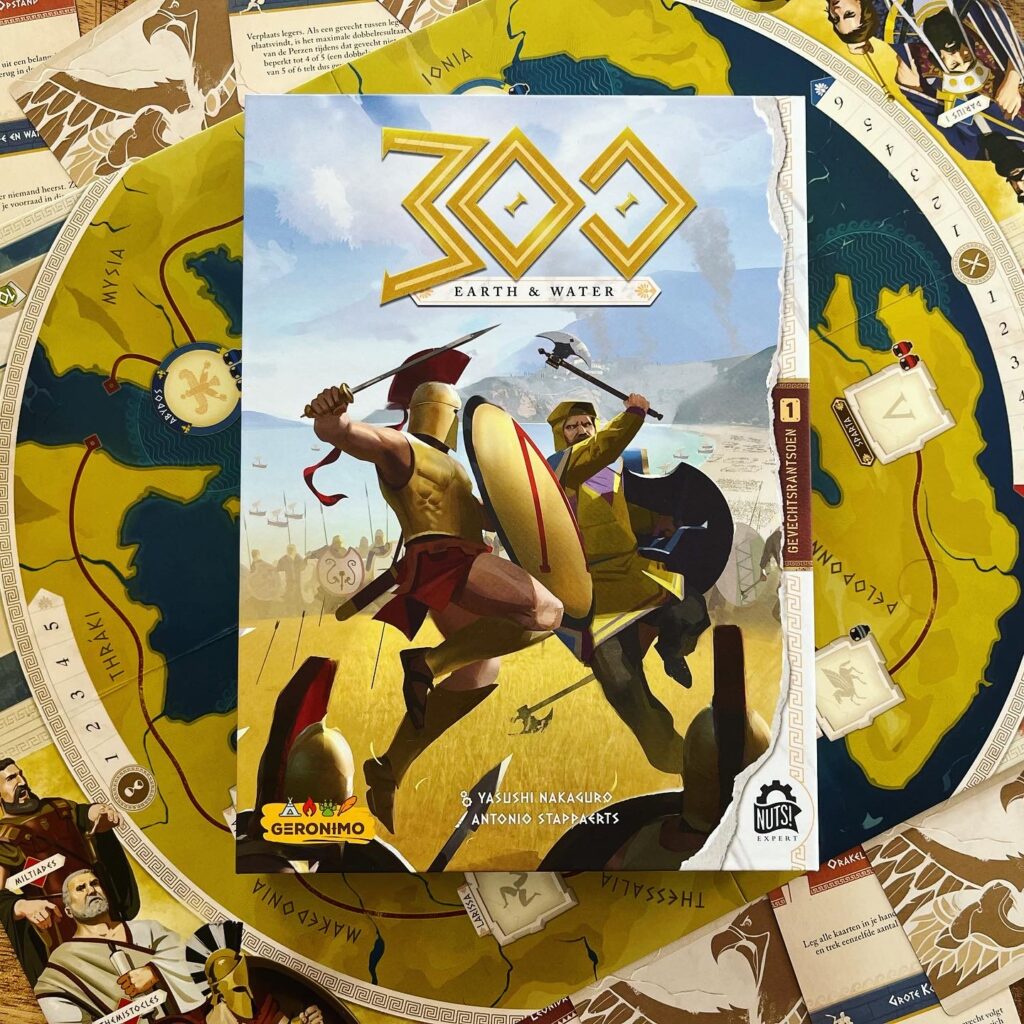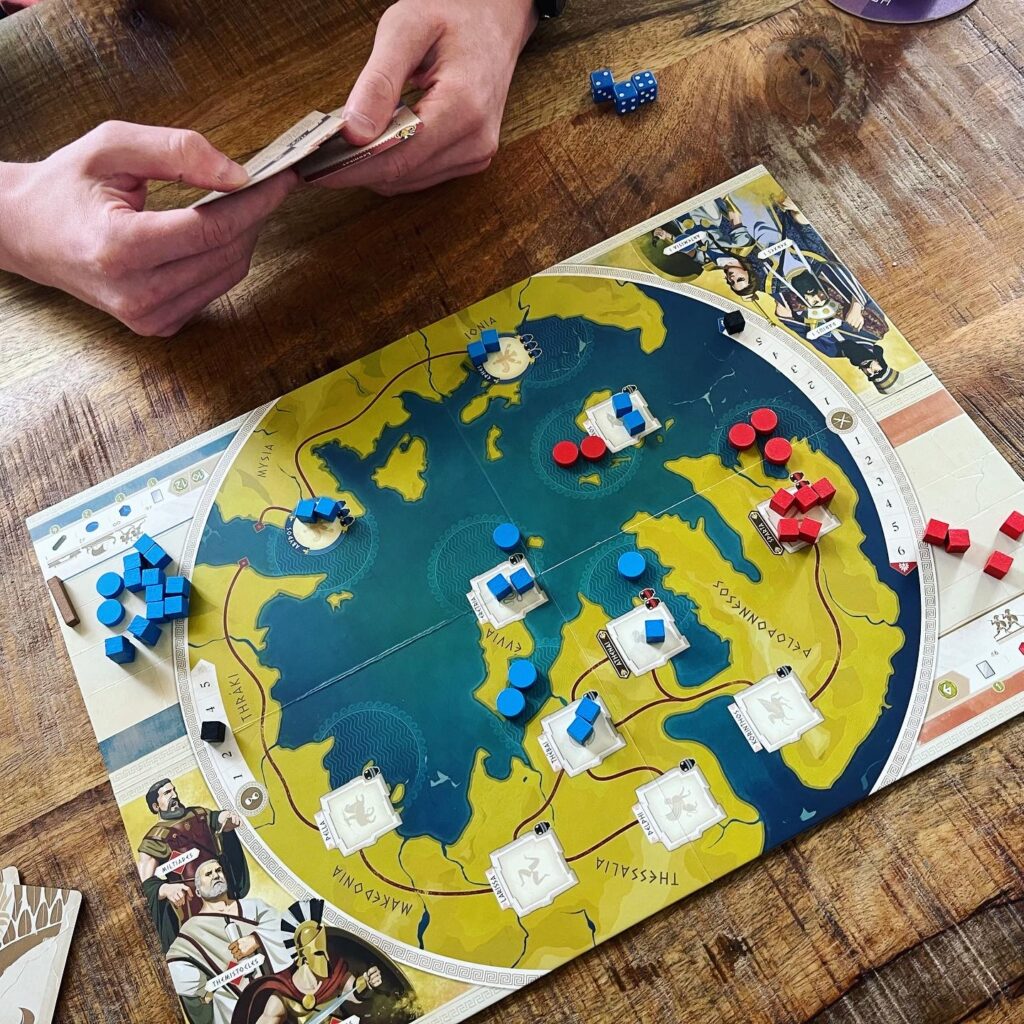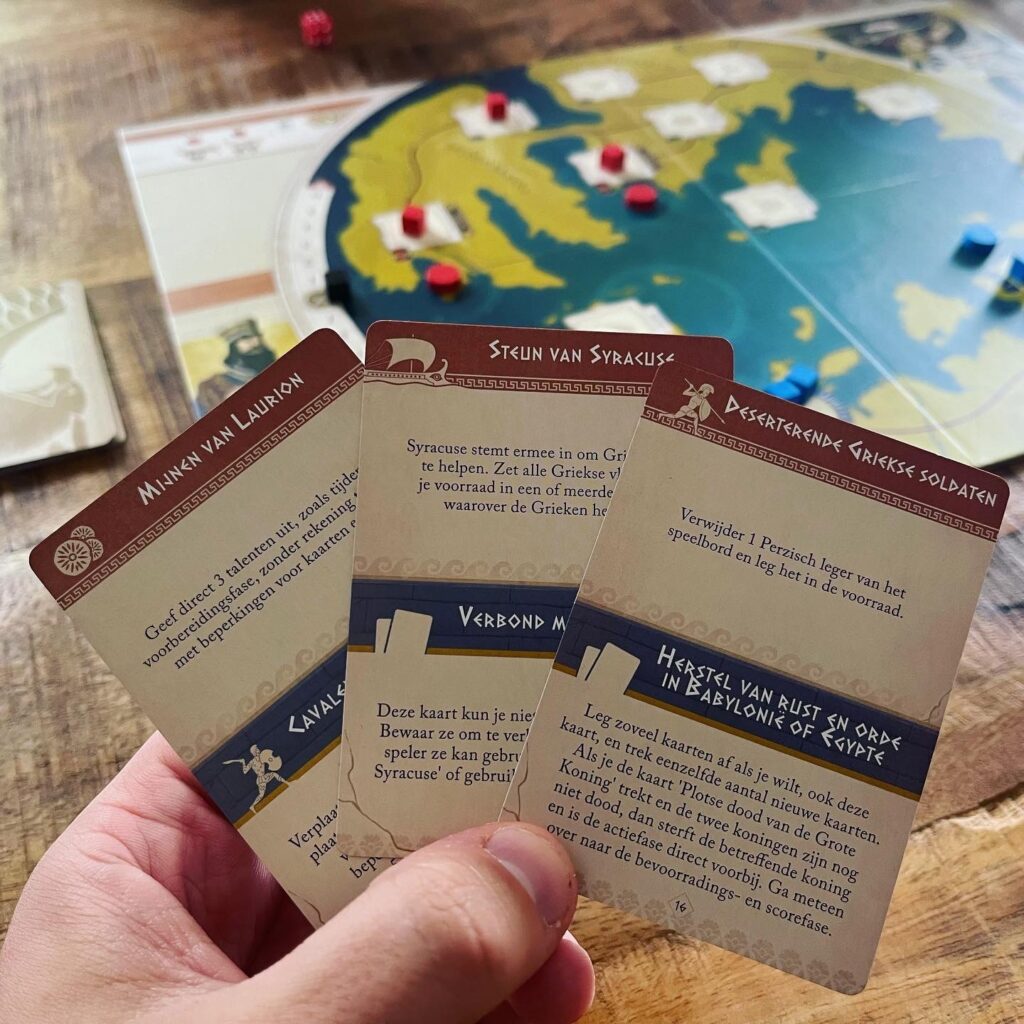You’ve probably seen (or heard of) Zack Snyder’s popular – and at the time aesthetically very original – film 300 about a small group of heroic Spartans who, led by the Spartan King Leonidas, were willing to die for their Greece by stopping a vast slave army of the Persian King Xerxes I. This film is based on a just as stylistic comic book series filled with violence and blood by the same name by author Frank Miller, also known for penning Sin City and The Dark Knight Returns. The story of the film and the comic book – taking various liberties – is based on the Battle of Thermopylae: a pivotal battle during the second Persian invasion of Greece led by Xerxes I, who decided, after the failed first invasion of his predecessor and father Darius I, that he could do much better. The Persian wars are also the inspiration for the wonderful two-player game 300 Earth & Water published by Geronimo Games and Nuts! Publishing.
Historical context
300 Earth & Water is an asymmetric war game for two players. The title of the game is a reference to the last stand of 300 Spartans after the withdrawal of the Greek armies at the Battle of Thermopylae, but also a reference to the demands for capitulation of the Greek city-states (Polis) made by the Persian invaders: earth and water, meaning: control over the land and all the resources that could be found on that land. Perhaps those demands sound familiar to you if you have watched the film 300, where a Persian envoy delivered this message to King Leonidas. In the film, Leonidas – not entirely swayed by the demands – kicks the envoy into a pit after shouting Leonidas’ famous words: This is Sparta! Although the film takes a liberal approach to history, it does incorporate elements of actual Greek history. The scene where an envoy is kicked into a well sounds fictionalized for the film, but actually has a historical basis. After the demands for earth and water were made, the Spartans seem to have actually thrown envoys into a well with the comment, “go ahead and find your own water.”

300 Earth & Water also draws inspiration from histories’ well (pun intended) and gives us a striking balance between historical accuracy and entertainment amongst others in terms of game play and the game mechanics. The influence of the theme already starts with the game’s set-up and goal. One player assumes the role of the combined armies of the Greek city-states and the other player assumes the role of the Persian superpower. The disparity between these two forces (and therefore between the players) could hardly be any greater. To give a specific example of the battle around Thermopylae: Greece began the battle with about 7,000 war-hardened men where the Persian army, despite a handful of elite troops such as the Immortals, consisted largely of inexperienced slaves and annexed, unwilling civilians, but had amassed an almost exaggeratedly large army. Greek legends speak of 3 million Persian troops, in the film the figure is 300,000 and a historical estimate gives an indication between 100,000 and 150,000 troops. You could say there was a rather large difference in size of the respective armies.
The foregoing provides sufficient basis for an asymmetrical setup and game play. The Greek player has fewer soldiers at his or her disposal, but – as the to be invaded party – naturally begins with access to more cities. Because of the experienced soldiers, the Greek player’s armies and fleets also have more combat power. However, the Greek player is isolated and therefore has a less efficient supply and less large war chest. The Persian player has a much larger force, but a smaller fleet and may not be able to deliver hard blows during a battle in unfamiliar territory. The Persian king also has an almost inexhaustible war chest.
Gameplay
300 Earth & Water, with its historical accuracy and asymmetrical nature, seems complex and overwhelming at first. But the small, component filled box contains a surprisingly elegant and intuitive game with a clear gameplay flow and plenty of choices. The game takes place during (up to) five campaigns (rounds) of the Persian army. At the beginning of each campaign, the Persian army prepares to attack and the Greek army prepares to defend and possibly even counterattack. I say up to five campaigns, because the game ends earlier if a player has conquered the two major cities of his opponent at the end of a round.
A round (campaign) is divided into the following phases:
- Preparation;
- Actions;
- Supply; and
- Score.
The game board depicts several cities. At the end of a round, a point count is done based on the cities a player has in his or her control. The difference determines how many spaces a cube moves along the point track towards a player. The player who has this cube on his or her side of the game board at the end of the five Persian less than friendly field trips wins the game. 300 Earth & Water is literally and figuratively a tug of war.
Preparation of a round
During the preparation phase, players have a war budget. This is because during this phase they can use their respective currencies (talents) to buy new armies, fleets and cards. In principle, the Persian player can spend 12 talents and the Greek player only 6. Fleets, however, are cheaper to buy and the Greek player has the ability to reserve more action cards and save these for subsequent rounds of the game. The Persian player can also build a pontoon bridge to connect the mainland and facilitate the invasion. Building this pontoon bridge was time-consuming and therefore is an expensive exercise.

Therefore, players have the choice of building their armies and fleets or buying action cards. Without action cards, they can’t take actions during the action phase, but with a small force a (counter)attack is a foregone conclusion. Players face major dilemmas each round. By the way, one of the cards contains an event: the sudden death of the king. If the Persian player draws this card at any time during a round, the specific campaign is immediately called off. First (possibly) Darius I dies and later (possibly) Xerxes I. So up to a maximum of two times the campaign can end prematurely. This creates tension and a degree of uncertainty that players try to take into account. Personally, I find this tension and uncertainty a very fun element of this game.
Actions and attacks
During the action phase, players are able to use their collected cards in different ways. Each card describes two actions. One of the actions can only be used by the Greek player and the other action by the Persian player. Action cards can also be played to move troops from one city and/or port to another city and/or port. Moving allows you to conquer cities or attack other players.
Once a player’s army or fleet enters a city under another player’s control, a battle takes place. Players roll an amount of dice depending on troop strength. Players compare their highest rolled values and the loser must discard a troop strength. The Persian player has less combat experience so can roll a maximum value of four or five if the combat takes place in Asia. The Greek player with armies filled with combat hardened Spartans, Athenians and Thespians can roll and use a value of six.

Each card and its corresponding action has a historical or cultural basis. The rule book lists the inspiration for each of these cards as part of an appendix. As a result, you can tell that the game was put together with care, skill and love for the subject and theme. This short reference is not necessary, but offers so much added value. Also, this makes it one of the most thematically accurate games I’ve played in a while, without the game losing sight of entertaining gameplay.
Almost each card has a different effect and the effects of some cards can only be used once. These cards often show a character who dies after using this card. Some cards cannot be used in a particular context. For example, the Persian player can play the card “Carneia Feast”. This feast is an important religious festival for the Spartans and thanks to this feast, they could not fully mobilize their army. In the context of the game, after this Persian player plays this card, the Greek player cannot take any actions related to Sparta (including Sparta related cards) for the rest of the round.
Supply and end of round
Players must be able to supply and feed their armies. Food is depicted on the various cities. Players must discard armies they cannot feed. Cities that are not connected to the important cities also lose troops. At the end of a round, players must also discard cards they have not used during a round. The Persian player may keep a single card for the next round, but this temporarily shrinks the war chest to ten talents. The Greek player, on the other hand, may save four cards and can thus prepare and arm himself against another invasion. Saving cards can also be a strategic choice in another way: as a way to keep another player from possible use of certain effects.
Verdict
I think the asymmetrical and historical aspects of the game are fantastically implemented. Despite being asymmetrical, the game feels balanced and I find that noteworthy. At no point does the game feel unfair. You may be unlucky during battles with the double-throws, but you can mitigate this bad luck by taking less risk and deploying more troops.

The gameplay is clear and intiutive. With a scarcity of currency to pay for the campaign, there is room for plenty of strategic and tactical choices. During the game, players face several dilemmas: what will they pay for and how will they engage the other player with their war apparatus? Do they play cards for their special abilities or to move armies? Which cities do they attack? Do they withdraw troops after a failed battle? Despite the many (choice) options, the game is elegant and surprisingly fast paced. The box has an indication stating the game can take circa 40 minutes, but the game is set up in seconds and quick game can last 20 minutes.
300 Earth & Water is a new personal favorite and highly recommended for two tactical players.



